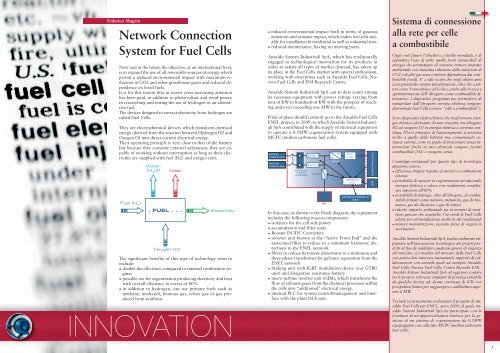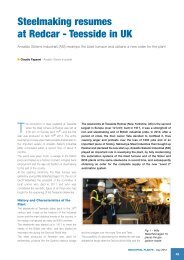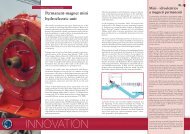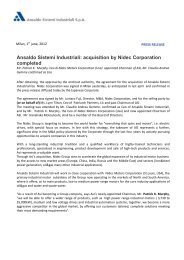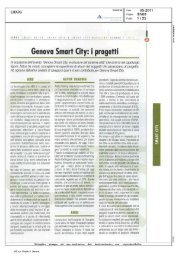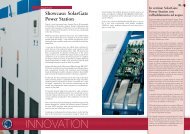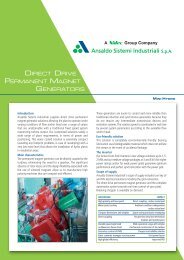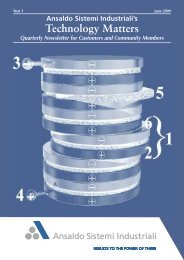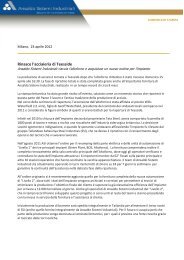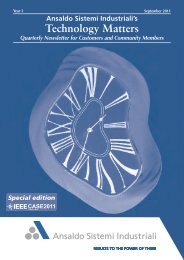Network Connection System for Fuel Cells - Ansaldo Sistemi Industriali
Network Connection System for Fuel Cells - Ansaldo Sistemi Industriali
Network Connection System for Fuel Cells - Ansaldo Sistemi Industriali
You also want an ePaper? Increase the reach of your titles
YUMPU automatically turns print PDFs into web optimized ePapers that Google loves.
2<br />
Federico Magrin<br />
<strong>Network</strong> <strong>Connection</strong><br />
<strong>System</strong> <strong>for</strong> <strong>Fuel</strong> <strong>Cells</strong><br />
Now and in the future the objective, at an international level,<br />
is to expand the use of all renewable sources of energy which<br />
permit a reduced environmental impact with maximum reduction<br />
in CO2 and other greenhouse gases and reduced dependence<br />
on fossil fuels.<br />
It is <strong>for</strong> this reason that in recent years increasing attention<br />
has been paid, in addition to photovoltaic and wind power,<br />
to researching and testing the use of hydrogen as an alternative<br />
fuel.<br />
The devices designed to extract electricity from hydrogen are<br />
called <strong>Fuel</strong> <strong>Cells</strong>.<br />
They are electrochemical devices which trans<strong>for</strong>m chemical<br />
energy (derived from the reaction between Hydrogen H2 and<br />
Oxygen O) into direct current electrical energy.<br />
Their operating principle is very close to that of the battery<br />
but because they consume external substances, they are capable<br />
of working without interruption as long as their electrodes<br />
are supplied with fuel (H2) and oxygen (air).<br />
<strong>Fuel</strong> (H 2 )<br />
Water<br />
(H 2 O) Heat<br />
. FUEL . . .<br />
Oxygen (O)<br />
Electricity<br />
The significant benefits of this type of technology seem to<br />
include:<br />
• double the efficiency compared to internal combustion engines<br />
• possible use <strong>for</strong> cogeneration producing electricity and heat<br />
with overall efficiency in excess of 80%<br />
• in addition to hydrogen, can use primary fuels such as<br />
methane, methanol, biomass gas, refuse gas or gas produced<br />
from synthesis<br />
INNOVATION<br />
• reduced environmental impact both in terms of gaseous<br />
emissions and acoustic impact, which makes fuel cells suitable<br />
<strong>for</strong> installation in residential as well as industrial sites.<br />
• reduced maintenance, having no moving parts.<br />
<strong>Ansaldo</strong> <strong>Sistemi</strong> <strong>Industriali</strong> SpA, which has traditionally<br />
engaged in technological innovation <strong>for</strong> its products in<br />
order to satisfy all types of market demand, has taken up<br />
its place in the <strong>Fuel</strong> <strong>Cells</strong> market with special enthusiasm,<br />
working with enterprises such as <strong>Ansaldo</strong> <strong>Fuel</strong> <strong>Cells</strong>, Nuvera<br />
<strong>Fuel</strong> <strong>Cells</strong> and ENI Research Centre.<br />
<strong>Ansaldo</strong> <strong>Sistemi</strong> <strong>Industriali</strong> SpA can to date count among<br />
its successes equipment with power ratings varying from<br />
tens of KW to hundreds of KW with the prospect of reaching<br />
and even exceeding one MW in the future.<br />
Pride of place should certainly go to the <strong>Ansaldo</strong> <strong>Fuel</strong> <strong>Cells</strong><br />
ENEL project, in 2009, to which <strong>Ansaldo</strong> <strong>Sistemi</strong> <strong>Industriali</strong><br />
SpA contributed with the supply of electrical equipment<br />
to operate a 0.5MW cogeneration system equipped with<br />
MCFC (molten carbonate fuel cells).<br />
MCFC #1<br />
2 stack in serie<br />
MCFC #2<br />
2 stack in serie<br />
AC Trafo<br />
Booster 1<br />
DC<br />
e �ltri<br />
Center<br />
Inverter<br />
Booster 2<br />
Power<br />
Protezione<br />
DC<br />
Precarica<br />
Chopper<br />
(eventuale) Quadro<br />
AC<br />
CONTROLLO<br />
(PCS)<br />
EPU<br />
SISTEMA DI CONTROLLO<br />
(DCS)<br />
In this case, as shown in the block diagram, the equipment<br />
includes the following macro-components:<br />
• isolators <strong>for</strong> the cell side power<br />
• accumulation and filter units<br />
• Booster DC/DC Converters<br />
• inverter unit known as the “Active Front End” and the<br />
associated filter to reduce to a minimum harmonic distortions<br />
to the ENEL network<br />
• filters to reduce harmonic distortions to a minimum and<br />
three-phase trans<strong>for</strong>mer <strong>for</strong> galvanic separation from the<br />
ENEL network<br />
• braking unit with IGBT modulation device (our GTBU<br />
unit) and dissipation resistance battery<br />
• micro turbine inverter unit (GIM), which trans<strong>for</strong>ms the<br />
flow of exhaust gases from the chemical processes within<br />
the cells into “additional” electrical energy.<br />
• internal PLC <strong>for</strong> system control/management and interface<br />
with the plant DCS unit.<br />
GIM<br />
Sistema di connessione<br />
alla rete per celle<br />
a combustibile<br />
Oggi e nel futuro l’obiettivo, a livello mondiale, è di<br />
espandere l’uso di tutte quelle fonti rinnovabili di<br />
energia che permettano di ottenere minore impatto<br />
ambientale con massima riduzione delle emissioni di<br />
CO2 e di altri gas serra e minore dipendenza dai combustibili<br />
fossili. E’ a tale scopo che negli ultimi anni<br />
si sta prestando sempre più attenzione, oltre che a settori<br />
come Fotovoltaico ed Eolico, anche alla ricerca e<br />
sperimentazione dell’ idrogeno come combustibile alternativo.<br />
I dispositivi progettati per permettere di<br />
estrapolare dall’idrogeno energia elettrica vengono<br />
denominati <strong>Fuel</strong> <strong>Cells</strong> (ovvero “celle a combustibile”).<br />
Sono dispositivi elettrochimici che tras<strong>for</strong>mano energia<br />
chimica (derivante da una reazione tra idrogeno<br />
H2 ed ossigeno O) in energia elettrica a corrente continua.<br />
Il loro principio di funzionamento si avvicina<br />
molto a quello delle batterie ma, consumando sostanze<br />
esterne, sono in grado di funzionare senza interruzioni<br />
finché ai suoi elettrodi vengono <strong>for</strong>niti<br />
combustibile (H2) e ossigeno (aria).<br />
I vantaggi sostanziali per questo tipo di tecnologia<br />
appaiono essere:<br />
• efficienza doppia rispetto ai motori a combustione<br />
interna<br />
• possibilità di operare in cogenerazione producendo<br />
energia elettrica e calore con rendimenti complessivi<br />
superiori all’80%<br />
• possibilità di impiego, oltre all’idrogeno, di combustibili<br />
primari come metano, metanolo, gas da biomasse,<br />
gas da discarica o gas di sintesi<br />
• ridotto impatto ambientale sia in termini di emissioni<br />
gassose che acustiche. Ciò rende le <strong>Fuel</strong> <strong>Cells</strong><br />
adatte per un’installazione anche in siti residenziali<br />
• minore manutenzione, essendo priva di organi in<br />
movimento<br />
<strong>Ansaldo</strong> <strong>Sistemi</strong> <strong>Industriali</strong> SpA, tradizionalmente impegnata<br />
nell’innovazione tecnologica dei propri prodotti<br />
al fine di soddisfare qualsiasi genere di esigenze<br />
del mercato, si è inserita nel mercato delle <strong>Fuel</strong> <strong>Cells</strong><br />
con particolare interesse instaurando rapporti di collaborazione<br />
con aziende quali ad esempio <strong>Ansaldo</strong><br />
<strong>Fuel</strong> <strong>Cells</strong>, Nuvera <strong>Fuel</strong> <strong>Cells</strong>, Centro Ricerche ENI.<br />
<strong>Ansaldo</strong> <strong>Sistemi</strong> <strong>Industriali</strong> SpA ad oggi può contare<br />
tra le proprie referenze impianti di potenza variabile<br />
da qualche decina ad alcune centinaia di KW con<br />
prospettive future per raggiungere e addirittura superare<br />
il MW.<br />
Tra tutti va sicuramente evidenziato il progetto di <strong>Ansaldo</strong><br />
<strong>Fuel</strong> <strong>Cells</strong> per ENEL, anno 2009, al quale <strong>Ansaldo</strong><br />
<strong>Sistemi</strong> <strong>Industriali</strong> SpA ha partecipato con la<br />
<strong>for</strong>nitura di un’apparecchiatura elettrica per la gestione<br />
di un sistema di cogenerazione da 0.5MW<br />
equipaggiato con celle tipo MCFC (molten carbonate<br />
fuel cells).<br />
3
4<br />
A very important control characteristic of the whole<br />
system which should be noted is that in addition to<br />
being able to track the voltage/current curve of the<br />
cells, it can automatically manage in abnormal conditions<br />
(such as network failure) the change to and operation<br />
of the plant in ISLAND mode: that is, the<br />
system is self sufficient and can power the plant equipment<br />
and auxiliaries even in the absence of the overall<br />
electrical network, using the micro turbine cogeneration<br />
system (GIM).<br />
Any excess energy is dissipated via an IGBT modulation<br />
device (GTBU) on a resistive load (EPU).<br />
Another interesting aspect is the modularity which<br />
may expand in line with user needs.<br />
Special attention has been given to reducing bulk<br />
which has resulted in electrical boards with a high degree<br />
of fill. This was made possible by the specific de-<br />
Federico Magrin<br />
sign of each individual component to reduce volume<br />
and the use of meticulous assembly techniques.<br />
In conclusion it is clear that the world of fuel cells is<br />
constantly developing.<br />
To date it remains a niche market, due above all to the<br />
high cost of hydrogen H2, and one which is perhaps<br />
not well known, but considering the wide range of potential<br />
fields in which <strong>Fuel</strong> <strong>Cells</strong> can be used (naval,<br />
military, biomass plant, hospitals, shopping centres<br />
etc.) it is expected that this market will become increasingly<br />
dynamic in the next few years with a consequent<br />
decrease in installation costs and costs of<br />
hydrogen supply.<br />
<strong>Ansaldo</strong> <strong>Sistemi</strong> <strong>Industriali</strong> SpA, strengthened by the<br />
high level of experience and expertise acquired in the<br />
last few years, is ready to take on the challenges presented<br />
by this promising market.<br />
INNOVATION<br />
Nella fattispecie, come evidenziato nello schema a<br />
blocchi, l’impianto comprende i seguenti macro-componenti:<br />
• organi di sezionamento della potenza lato celle<br />
• unità di accumulo e filtraggio<br />
• convertitori Booster DC/DC<br />
• unità inverter denominata “Active Front End” e relativo<br />
filtraggio per ridurre al minimo le distorsioni<br />
armoniche verso la rete ENEL<br />
• filtri per ridurre al minimo le distorsioni armoniche<br />
e tras<strong>for</strong>matore trifase per separazione galvanica<br />
dalla rete ENEL<br />
• unità di frenatura realizzata con dispositivo di modulazione<br />
ad IGBT (ns. unità GTBU) e batteria di<br />
resistenze di dissipazione<br />
• unità inverter di comando della microturbina<br />
(GIM), la quale sostanzialmente tras<strong>for</strong>ma in energia<br />
elettrica “addizionale” il flusso di gas esausti<br />
derivanti dai processi chimici interni alle celle<br />
• unità PLC interna per controllo/gestione del sistema,<br />
e interfaccia con unità DCS d’impianto<br />
Da notare una caratteristica molto importante dell’intero<br />
sistema, legata al controllo, che oltre ad essere in<br />
grado di seguire la curva tensione/corrente delle celle,<br />
ha la capacità di saper gestire automaticamente in<br />
condizioni anomale (mancanza rete, …) il passaggio<br />
e l’esercizio dell’impianto in modalità ISOLA: ovvero<br />
il sistema è in grado di autosostenersi e di alimentare<br />
le utenze e gli ausiliari d’impianto anche in assenza<br />
della rete elettrica prevalente, sfruttando anche la presenza<br />
del sistema cogenerativo a microturbina (GIM).<br />
L’eventuale energia in esubero viene dissipata mediante<br />
un dispositivo di modulazione a IGBT (denominato<br />
GTBU) su un carico resistivo (EPU).<br />
Altra interessante peculiarità è certamente la modularità,<br />
che può crescere a seconda della domanda<br />
dell’utente. Particolare attenzione è stata posta alla<br />
riduzione ingombri che ha avuto come risultato la<br />
realizzazione di quadri elettrici con elevato fattore di<br />
riempimento. Questo è stato possibile attraverso la<br />
progettazione specifica su ogni singolo componente<br />
finalizzata al contenimento dei volumi, e a tecniche<br />
di assemblaggio minuziose.<br />
Per concludere è chiaro che il mondo delle celle a<br />
combustibile è in continua evoluzione.<br />
Ad oggi è ancora un mercato di nicchia, dovuto soprattutto<br />
agli elevati costi dell’idrogeno H2, e <strong>for</strong>se<br />
non completamente conosciuto, ma considerati i potenziali<br />
bacini d’utenza ai quali le <strong>Fuel</strong> <strong>Cells</strong> sicuramente<br />
potranno far riferimento (applicazioni in<br />
campo navale, militare, impianti a biomasse, ospedali,<br />
centri commerciali, …) ci si aspetta una progressiva<br />
maggiore dinamicità di questo mercato negli<br />
anni immediatamente futuri con una conseguente<br />
flessione sui costi d’installazione e di approvvigionamento<br />
dell’idrogeno.<br />
<strong>Ansaldo</strong> <strong>Sistemi</strong> <strong>Industriali</strong> SpA, <strong>for</strong>te dell’alto valore<br />
delle competenze acquisite in questi ultimi anni, è<br />
pronta ad affrontare le sfide che questo promettente<br />
mercato proporrà.<br />
5


